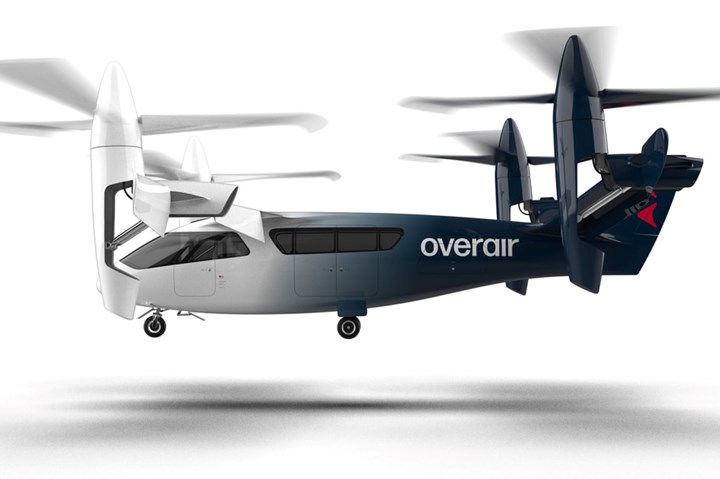Overair receives $145 million investment from Hanwha Group to develop eVTOL aircraft
Electric vertical takeoff and landing (eVTOL) startup will fly composite Butterfly experimental prototype in 2023, with plans to provide practical aerial ridesharing.
On June 14, electric vertical takeoff and landing vehicle (eVTOL) company, Overair (Santa Ana, Calif., U.S.) announced its most recent $145 million funding from Hanwha Systems (Changwon, South Korea) and Hanwha Aerospace, known for ultra-precision communications and aircraft technologies. With this new investment, Overair says it remains on track to fly its all-electric experimental prototype, Butterfly, which is to make use of composites, in the second half of 2023.
In addition to fueling Overair’s ongoing development of Butterfly, the investment will enable the company to lay the groundwork for commercialization. Hanwha will also be providing electric motors and battery packs for Overair’s prototypes, as the two companies expand R&D co-operation.
“This is a tremendous milestone for our growing team, and we’re well positioned to deliver sustainable aerial ridesharing to the world through the development of Butterfly,” Ben Tigner, co-founder and CEO of Overair, says. “We’re exactly where we want to be, building an aircraft company with class-leading mobility technology while rapidly approaching the first flight of a purpose-built prototype next year. We’ve proven Butterfly’s propulsion system, so we’ll now begin validating Butterfly’s ability to operate safely in real-world weather conditions, carry significant payloads and fly quietly.”
Butterfly is an all-electric aircraft with six seats designed to take off and land vertically. The aircraft’s advanced propulsion system is said to be derived from decades of military VTOL programs led by Abe Karem. Thanks to this legacy of proprietary engineering, Overair contends that Butterfly’s propulsion is highly efficient and will give the eVTOL the broadest flight envelope and smallest sound footprint of any aircraft. Specifically, Butterfly’s optimum speed propulsion (OSP) uses four large propellers, which spin slowly when hovering and even slower when cruising, and reportedly draw only a fraction of the available motor power, giving Butterfly extra payload capacity and power margins to operate safely in challenging environmental conditions. Additionally, the slow-turning props produce little sound, which will enable Butterfly to operate in high-density areas with noise-sensitive communities.
“With regard to our investment decision in Overair, we assessed that the company had the numerous patents and core technologies required to develop[a] highly efficient, low-noise vehicle,” Sungchul Eoh, CEO of Hanwha Systems, says. “Therefore, we expected that Overair would be capable of developing [a] superb vehicle that can satisfy the requirements for safety, efficiency, speed, low noise and environment-friendly features.”
As the company continues to work toward Federal Aviation Administration (FAA) certification, Overair is also working with NASA (Washington, D.C., U.S.) and Urban Movement Labs (Los Angeles, Calif., U.S.) to develop urban air mobility (UAM) routing and infrastructure.
Related Content
-
Development of a composite liquid hydrogen tank for commercial aircraft
Netherlands consortium advances cryogenic composites testing, tank designs and manufacturing including AFP, hybrid winding, welding of tank components and integrated SHM and H2 sensors for demonstrators in 2025.
-
Low-cost, efficient CFRP anisogrid lattice structures
CIRA uses patented parallel winding, dry fiber, silicone tooling and resin infusion to cut labor for lightweight, heavily loaded space applications.
-
MFFD longitudinal seams welded, world's largest CFRTP fuselage successfully completed
Fraunhofer IFAM and partners have completed left and right welds connecting the upper and lower fuselage halves and sent the 8×4-meter full-scale section to ZAL for integration with a cabin crown module and testing.

















